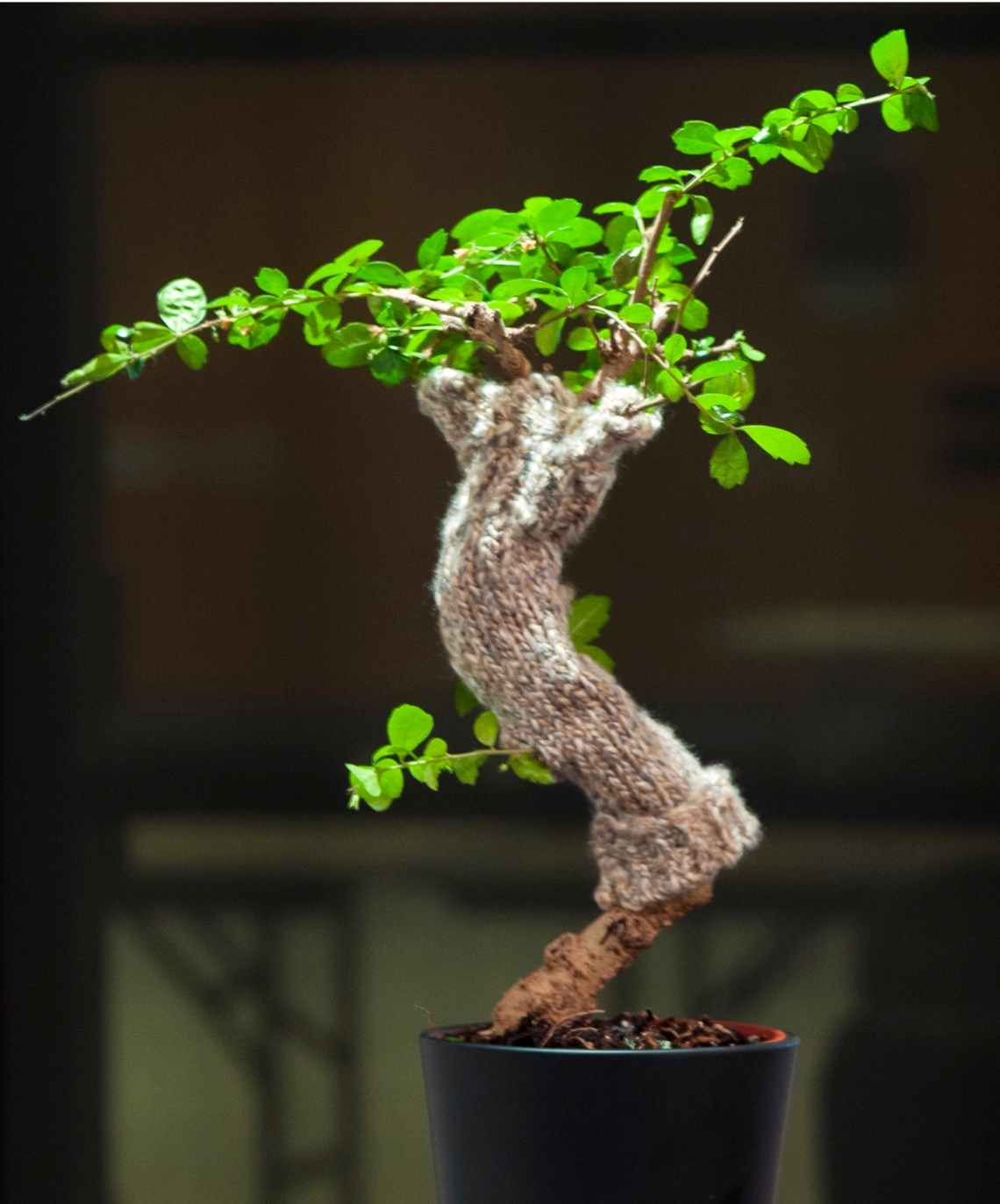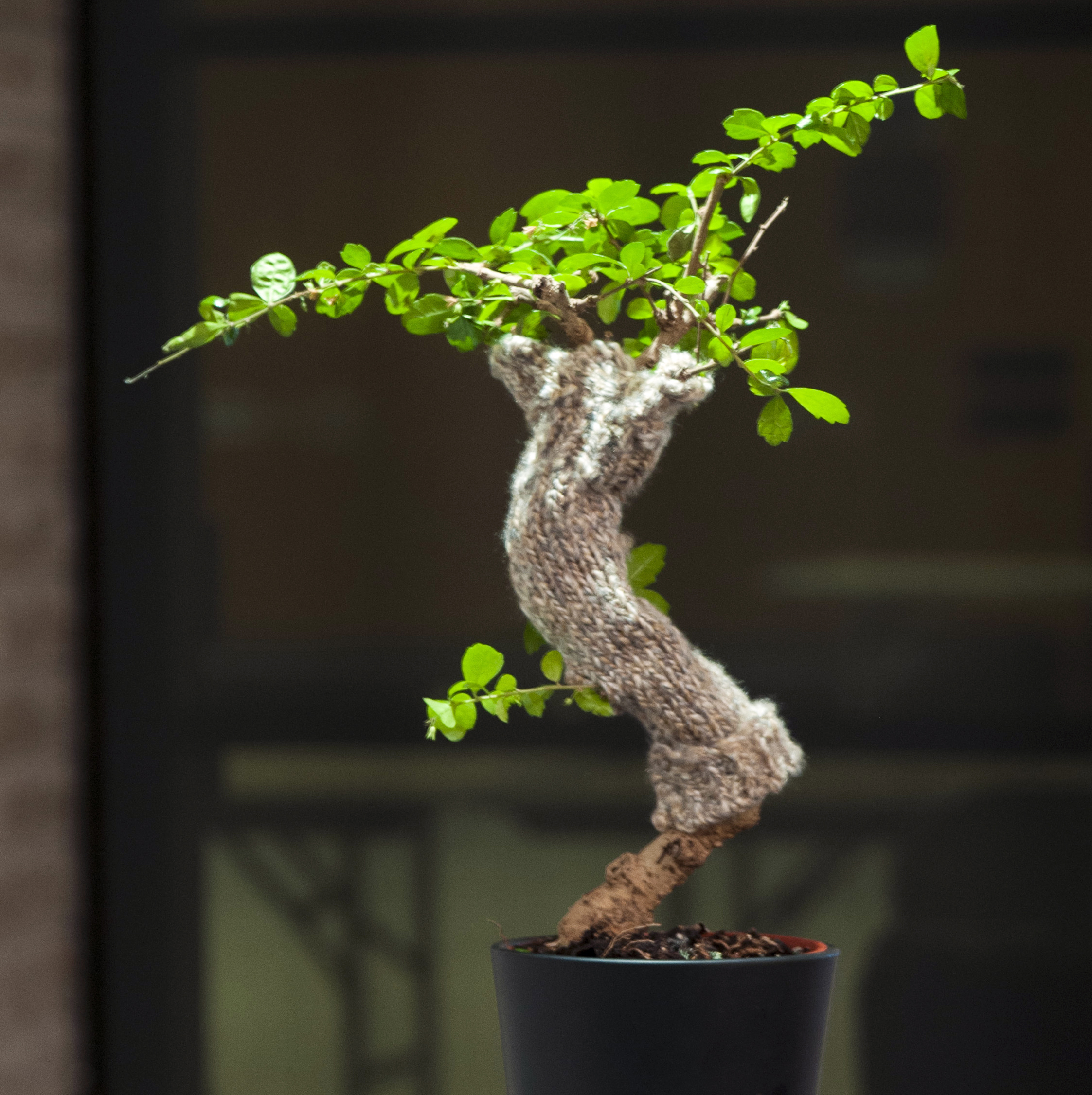
I am a sculptor who is interested in my culture’s interactions with the natural world. The pieces that I make often concern the concept of a biotope—small environments that are shared by multiple species, including humans. This work may also involve the notion of “trans-species giving.” Which is an idea that the commonalities between humans and other life forms are such that we humans may be able to give other life forms a “hand-up” however misguided or conceptually hamstrung we may be by our own culture’s interactions with the natural world.
Above, at the side, and at the end of this post are images of Plant Sweaters, 2014, sculptures that involve live plants wearing knit sweaters. I created this 2014 series and a number of other works for “Welcome To The Anthropocene,” an exhibition at this year’s Association of Environmental Science Studies (AESS) Conference at Pace University. The organization gave me a solo exhibition and dedicated a symposium to my artwork in recognition of the ways that the pieces I make have addressed anthropocene issues over the past decade. The exhibition showcased a number of recent works including a live web feed of the IndaPlant Project: http://elizbethdemaray.org/2014/07/21/indaplant-community-live-on-webcam/, the Endangered Species Recipe Book: http://elizbethdemaray.org/2014/10/30/the-endangered-species-recipe-book/, and a updated version of the Songs We Sing that I originally created for the Lloyd in Amsterdam: http://demaray.camden.rutgers.edu/2013/05/24/the-songs-we-sing-amsterdam-at-the-lloyd/
Upon learning of this honor form Jennifer Joy Pawlitschek, the AESS Art Director, I started to consider which pieces that I’ve been working on that might be relevant to the idea of the

“anthropocene.” As an artist who works in eco-art, new media and art and science collaboration, I’m an oddball in the art world. I make works that are not aimed at being sold, are extremely context specific and utilize a wide range of mediums and technologies. My pieces, which are always the result of a constellation of my preoccupations, may at first glance not look like a continuous body of work. In the past, I’ve countered this issue by typically only exhibiting one work at a time. However, when I considered the anthroposcene in the context of my work, I looked around my studio and I realized that everything I make is directly applicable to this concept. My artwork actually belonging here, at this symposium, has really been the oddest and most wonderful experience for me at the AESS conference. During this meeting of environmental studies people, I feel like I’ve finally found my peers and my home.
The dedicated addition of artists at the conference also played a large role in my experience of

belonging at the symposium. The association allowed me to assist in curating nine other artists directly onto the environmental studies panels. Two other additional superb artist panels, put together by Peter Anderson, additionally added to the number of really extraordinary artists who participated in the conference. The interesting thing about these artists is that many of them had the exact same experience that I did at AESS; the feeling that we had finally found our family in a way that we never had in the art world.
All of this is a long pre-amble to Plant Sweaters, 2014. I began knitting sweaters for plants when I was in graduate school at UC Berkeley in 1997. At the time I wanted to help the natural world, but felt ineffectual in my efforts. The plant sweaters are a result of my desire to manafest this dilemma. Creating this series for Welcome To The Anthropocene at AESS, has afforded me the time to consider the ways that my orientation to this work has changed over the course of my career. I am still interested in my culture’s interactions with the natural world. The only difference is that now I’m feeling the full effect of my efforts.



Reblogged this on mcollinsanderson and commented:
Finally the living aspects of Nature and the stark contract of industrialization merge together. Rich soil, steel both accenting and engulfing, plastics and man made material all emphasizes the pieces contrast mediums. The free-flowing form of the plant life also is in contrast to the rigid and undeniable shapes of man made form. The name alone, The IndaPlant Project: An Act Of Trans-Species Giving— illustrates the marriage and integration of the two different mediums. The colorful wheels are emphasized, emphasizing the journey of the work; the relationship between the two and the difficult road it has taken to get there. The piece also symbolizes the positive nature and effects that happen when two drastically different aspects of culture work together. As a whole it is recognized as a new era, symbolic of separation from the industrial period and the naturalistic approach but a combination of the two.